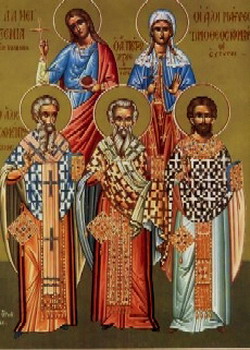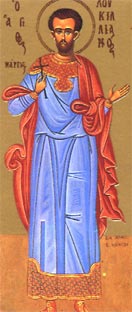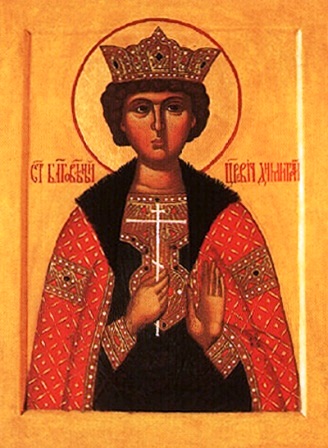|
|
The Holy Martyr Lucillian and those with him: Claudius, Hypatius, Paul, Dionysius and the Virgin Paula Lucillian grew to old age as a pagan priest. Only as a grizzled old man did he learn the truth of Christianity and receive baptism. His conversion to Christianity caused great excitement among the pagans of Nicomedia, and he was brought to trial for refusing to deny his new faith. He was harshly whipped and, all black and blue, thrown into prison. In the prison were four young men: Claudius, Hypatius, Paul and Dionysius, who had likewise been imprisoned for the Faith. The old man rejoiced in the company of these young men, and they in his, and they spent their time together in spiritual converse, prayer and the singing of psalms. When they were taken from the prison, they were tortured in various ways and then taken to Byzantium, where the young men were beheaded with the sword by the soldiers, and Lucillian crucified by the Jews. The wicked Jews pierced his body all over with nails. A maiden, Paula, openly took the martyrs' bodies and gave them burial. She was denounced for this and, after torture, was beheaded, receiving a twofold wreath: of virginity and of martyrdom. Their martyrdom took place in the time of the Emperor Aurelian, between 270 and 275. Lucillian grew to old age as a pagan priest. Only as a grizzled old man did he learn the truth of Christianity and receive baptism. His conversion to Christianity caused great excitement among the pagans of Nicomedia, and he was brought to trial for refusing to deny his new faith. He was harshly whipped and, all black and blue, thrown into prison. In the prison were four young men: Claudius, Hypatius, Paul and Dionysius, who had likewise been imprisoned for the Faith. The old man rejoiced in the company of these young men, and they in his, and they spent their time together in spiritual converse, prayer and the singing of psalms. When they were taken from the prison, they were tortured in various ways and then taken to Byzantium, where the young men were beheaded with the sword by the soldiers, and Lucillian crucified by the Jews. The wicked Jews pierced his body all over with nails. A maiden, Paula, openly took the martyrs' bodies and gave them burial. She was denounced for this and, after torture, was beheaded, receiving a twofold wreath: of virginity and of martyrdom. Their martyrdom took place in the time of the Emperor Aurelian, between 270 and 275.The Hieromartyr Lucian A Roman, renowned for his noble birth, wealth and learning, he was for a time a disciple of the Apostle Peter. Later, Pope Clement sent him, together with Dionysius the Areopagite, to Gaul to preach the Gospel, consecrating them bishop before they set out. Lucian sowed the seed of Christ"s teaching with great zeal, first in Gaul and then in Belgium. When the wicked Emperor Domitian began persecuting the Christians, men were sent from Rome to seek out the Christian missionaries and arrest them. They first seized and killed Dionysius, and then set off in pursuit of Lucian. Finding him in Belgium, together with his helpers, the priest Maxianus. and the deacon Julian, they killed these two in one place and beheaded Lucian in another. When Lucian had been beheaded, his dead body rose from the ground and, taking its head into its hands (like St Dionysius and St John Vladimir), walked thus to the spot at which it wished to be buried. There it fell to the ground, and was there buried. A church was later built over his relics. A Roman, renowned for his noble birth, wealth and learning, he was for a time a disciple of the Apostle Peter. Later, Pope Clement sent him, together with Dionysius the Areopagite, to Gaul to preach the Gospel, consecrating them bishop before they set out. Lucian sowed the seed of Christ"s teaching with great zeal, first in Gaul and then in Belgium. When the wicked Emperor Domitian began persecuting the Christians, men were sent from Rome to seek out the Christian missionaries and arrest them. They first seized and killed Dionysius, and then set off in pursuit of Lucian. Finding him in Belgium, together with his helpers, the priest Maxianus. and the deacon Julian, they killed these two in one place and beheaded Lucian in another. When Lucian had been beheaded, his dead body rose from the ground and, taking its head into its hands (like St Dionysius and St John Vladimir), walked thus to the spot at which it wished to be buried. There it fell to the ground, and was there buried. A church was later built over his relics.The Holy Martyr Dimitri, Tsarevitch of Russia He received a martyr"s death at the age of eight at the hands of the power-hungry Boris Godunov, in the town of Uglich in 1591. He appeared after his death to a monk and prophesied that a false Dimitri would appear, who would bring about Boris Godunov"s murder. This came to pass. Innumerable miracles were wrought at the grave of the martyred Tsarevitch. His relics were dug up fifteen years later, whole and uncorrupt, and were transferred solemnly to Moscow and buried in the Church of the Archangel Michael. He received a martyr"s death at the age of eight at the hands of the power-hungry Boris Godunov, in the town of Uglich in 1591. He appeared after his death to a monk and prophesied that a false Dimitri would appear, who would bring about Boris Godunov"s murder. This came to pass. Innumerable miracles were wrought at the grave of the martyred Tsarevitch. His relics were dug up fifteen years later, whole and uncorrupt, and were transferred solemnly to Moscow and buried in the Church of the Archangel Michael.St. Hieria, widow, of Mesopotamia (312)The Nun Hieria was born into a pagan family, and became the wife of a Roman senator, but after a mere 7 months was widowed. While in the Assyrian city of Seuapolis, she learned that in the vicinity of the city of Niziba there was a women's monastery, in which asceticised the young Monastic Febronia, distinguished for her particularly strict life. Under the guise of a wanderer, Hieria visited her and conversed with her all night, being instructed in the Christian faith, and then having returned home, she was baptised and persuaded her parents to do likewise.
During the time of the persecution by Diocletian (284-305), the majority of the inhabitants of the Niziba monastery left and hid away from the persecutors, but Saint Febronia was brought to trial before the cruel official Selinus and for her confession of Christ she was subjected to inhuman tortures. Saint Hieria intrepidly denounced the cruelty of the torturers. The judge gave orders to arrest and torture her also, but then he changed his mind, in learning that Saint Hieria – was the widow of a Roman senator.
Bitterly bewailing the martyr's death of Saint Febronia (+ c. 304, Comm. 25 June), Hieria grieved, that she herself had not been vouchsafed to suffer for the faith in Christ. With tears she besought the hegumeness Brienna to accept her in place of Febronia at the monastery. Having bestown all her substance upon the monastery, the nun Hieria spent there the remaining days of her life and peacefully reposed to God in about the year 320.
Venerable Pappus monkУ миру се преставио у Господу.
Venerable Athanasius, the wonderworker of Cilicia
|